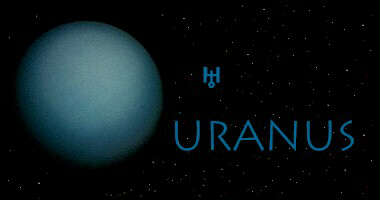|
|
|
 |
Discovered on March 13, 1781 by Sir William Hershel, Uranus is the seventh planet from the Sun and the third largest (by diameter). Uranus is the ancient Greek god of the Heavens, but was dethroned by his son Cronus.
The innermost ten moons: Cordelia, Ophelia, Bianca, Cressida, Desdemona, Juliet, Portia, Rosalind, Belinda, and Puck. Satellites Miranda, Ariel, Umbriel, Titania, and Oberon. Note: The names of the moons and satellites of Uranus are an exception. While all the other moons and satellites are named after characters from Greek and Roman mythology, those of Uranus have literary names (from Shakespeare and Pope).
Uranus is part of the modern astrological system, as it was unknown to the Ancients, and thus has no benefic or malefic quality attached to it. Where Uranus is found, is where you experience changes, upsetting conditions, and sudden reversals. In the areas signified by the house position, you will have to use all your skills to survive many changes or you will be demolished. Representing sudden change, it can be either positive or negative, depending upon our own circumstances. Interesting to note, that the planet is unusual in that it has an almost 90 degree tilt, so it spins on its side. "Unusual" is a keyword used in describing Aquarians, the sign that Uranus rules.
Freedom and change are its keywords, and it usually brings new experiences and ideas to which we must adjust. Never static, always changing, and usually very quickly, that is Uranus. The modern ruler of Aquarius, Uranus rules inventiveness, rebellion, genius, science, astrology, electronics, computers. As the higher octave of Mercury (conscious thought), it is also referred to as the Awakener, and its purpose is to bring new ideas to the conscious mind, to show us something we have never before noticed, all for the purpose of freeing us from our own mental limitations.
Physically, Uranus rules the lower legs, ankles, calves, body electricity, spasms, tension, and nervous conditions.
In the area of colors, gemstones, and metals, Aquarius is associated with white, pale yellow, pale green, and electric blue; the gem of amethyst; and the metal of uranium.
![]()
![]() Astronomical
data:
Astronomical
data:
Methane in the upper atmosphere absorbs red light, giving Uranus its blue-green color. The atmosphere is arranged into clouds running at constant latitudes, similar to the orientation of the more vivid latitudinal bands seen on Jupiter and Saturn. Winds at mid-latitudes on Uranus blow in the direction of the planet's rotation. These winds blow at velocities of 40 to 160 meters per second (90 to 360 miles per hour). Radio science experiments found winds of about 100 meters per second blowing in the opposite direction at the equator.
Uranus is notable because of the fact that it is tipped on its side. The planet rotates on its axis every 17 hours and the tilt of the planet is quite a unique aspect of Uranus. The tilt remains a mystery, yet, astronomers believe it was due to a planet-sized object crashing into Uranus early in the solar system's formation. The poles are not on the top and bottom like the Earth's, but instead on its sides. The planet spins from north to south instead of west to east like on Earth.
Voyager 2 found that one of the most striking influences of this sideways position is its effect on the tail of the magnetic field, which is itself tilted 60 degrees from the planet's axis of rotation. The magnetotail was shown to be twisted by the planet's rotation into a long corkscrew shape behind the planet. The magnetic field source is unknown; the electrically conductive, super-pressurized ocean of water and ammonia once thought to lie between the core and the atmosphere now appears to be nonexistent. The magnetic fields of Earth and other planets are believed to arise from electrical currents produced in their molten cores.
Uranus travels on an oval-like shape around the Sun at 4 miles every second. Because the east and west hemispheres of Uranus do not rotate away from the sun, each face of Uranus faces the sunlight from forty-two Earth days as the planet moves through its eighty-four year orbit. Each of the four seasons lasts for twenty-one Earth years on Uranus.
Uranus' Rings: In 1977, the first nine rings of Uranus were discovered. During the Voyager encounters, these rings were photographed and measured, as were two other new rings and ringlets. Uranus' rings are distinctly different from those at Jupiter and Saturn. The outermost epsilon ring is composed mostly of ice boulders several feet across. A very tenuous distribution of fine dust also seems to be spread throughout the ring system.
[Sun] [Moon]
[Mercury] [Venus] [Mars]
[Jupiter] [Saturn] [Uranus]
[Neptune] [Pluto]
*Astrological Backgrounds Menu*
![]()